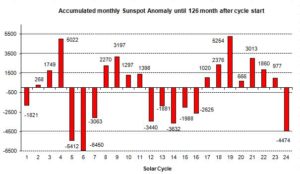by Nicole Hul, June 20, 2019 in Narcity
Summer officially kicks off tomorrow – but that doesn’t mean that the nice, hot weather typically associated with summer is coming, at least not to some parts of Canada. Even though winter technically ended several months ago, wintery, snowy weather hasn’t stopped reigning down in a number of regions in the country. The Alberta weather forecast shows snowfall of up to 10 cm by the first day of summer. Is summer cancelled?
It’s already been snowing in several provinces in June. While spring snow was already unusual, summer snow is even more bizarre.
Yesterday on Wednesday, Environment Canada issued a snowfall warning for Jasper National Park in Alberta, forecasting up to 10 cm of snow. Now, they are extending their warning, and even adding a new region.
…

Marc Bruxelle, Dreamstime.com
by F. Bosse & F. Vahrenbolt, June 22, 2019 in NoTricksZone
In May 2019 our sun was below-normal active again. The solar sunspot number (SSN) was 10.1, which is only 52% of the mean value in the evaluated cycle month no. 126 since the start of Cycle No. 24 began in December 2008.
It should be noted that the number of cycles that lasted this long is decreasing. In the previous month we reported on cycles 21, 18, 16, 15, 8 dropping out because they were shorter in total, and now SC 17 is getting added. Next month month SC 7 is will fall as well. The mean value thus becomes less meaningful as the end of the cycle approaches. But out of habit, we want to keep it nevertheless as comparison.
The activity in the past month was shifted very asymmetrically to the solar northern hemisphere, the southern hemisphere was spotless throughout the whole month. The solar north saw spots only on 15 days.
…

Fig. 2: Sunspot activity of the individual cycles since the beginning of cycle 1 in the year 1755. The numbers are computed by adding up the monthly differences of the observed cycles to the mean value, up to the current cycle month no. 126.
…
La géologie, une science plus que passionnante … et diverse


